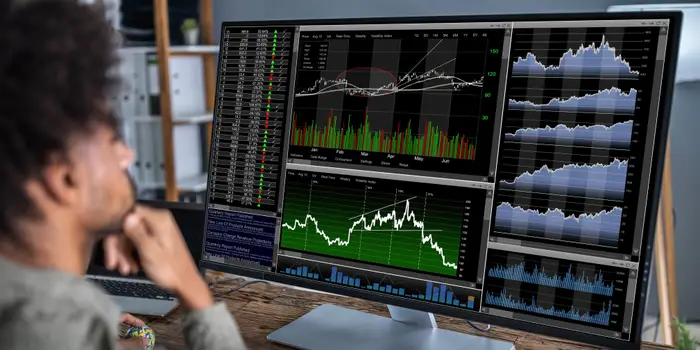Detailed Guide on the Best Time Frame for Day Trading
Discover the best time frame for day trading with this clear, practical guide designed to help improve your trading decisions and timing.

Day trading is all about timing. Knowing when to make your move can mean the difference between winning and losing. However, with so many time frames to choose from, it can be challenging to know where to begin. That's where Smart Money Trading comes in. By understanding the optimal time frame for day trading, you can align your strategies with those of the most successful traders in the market. This guide can help you make more consistent profits and achieve your trading goals.
Aqua Funded's funded trading program can help you take your day trading to the next level. With this program, you can access a pool of capital and begin trading with confidence.
Benefits of Day Trading

Chasing Big Returns: The Allure of Day Trading
Day trading offers the tantalizing potential for substantial profits. With the ability to use leverage, even minor price shifts can translate into significant gains. If you’ve got the knack for spotting market trends quickly and decisively, the financial rewards can be substantial. Think of it as turning small opportunities into big wins.
Trade on Your Terms: The Freedom of Day Trading
One of the most attractive features of day trading is the freedom it provides. You’re not tied to an office or a rigid schedule. As long as you have an internet connection, you can trade from anywhere. Set your hours, devise your strategies, and break free from the traditional 9-to-5 routine. It’s about creating the life you want while doing what you love.
Quick on the Draw: The Thrill of Fast Decision-Making
Day trading is a fast-paced world that sharpens your ability to make quick decisions. You need to analyze market conditions rapidly and act on them immediately. This environment can be both intellectually stimulating and rewarding for those who thrive in high-pressure situations. It’s like a mental workout that keeps you sharp and engaged.
Rest Easy: Limited Drawdowns with Day Trading
With day trading, you close all positions by the end of the trading day. This means you’re not exposed to the risks of overnight market changes that could affect your trades. It’s a way to keep your drawdowns in check and maintain control over your investments. You can sleep soundly knowing you’re not leaving anything to chance overnight.
Always in Motion: The Liquidity and Accessibility of Day Trading
Day trading in highly liquid markets allows you to buy and sell assets with ease. There’s always someone ready to take the other side of your trade. Plus, with the rise of online trading platforms, day trading has become more accessible than ever. It’s a path open to anyone willing to learn and take the plunge.
Learn Fast: Immediate Feedback on Your Trading
Day trading offers instant feedback on your strategies and decisions. This real-time evaluation helps you learn from mistakes and refine your approach quickly. It’s a way to accelerate your development as a trader and improve your skills at a rapid pace. You’re constantly learning and adapting, making every day an opportunity for growth.
Is Day Trading Profitable

The Reality Check: Most Day Traders Lose Money
The truth is that most day traders ultimately end up losing money. Studies paint a stark picture: only around 10% of day traders consistently generate a profit. Research from the University of California found that only 13% of traders were profitable over a six-month period. Another study indicated that a mere 1% could reliably beat the market after accounting for costs. Profitability is possible, but it’s rare and demands skill, discipline, and a robust strategy.
Unrealistic Expectations: Day Trading Returns
Many traders jump in expecting to rake in double-digit monthly returns. In reality, even professionals at institutions aim for 10-15% annual growth. For retail traders, consistent 1% daily gains are a stretch. This would mean over 250% yearly returns, nearly impossible to maintain when you factor in costs, taxes, and the emotional grind.
The Impact of Trading Costs
Trading costs can eat into your profits, even if you’re skilled. Commissions, spreads, and slippage add up fast, especially if you trade every day. These costs multiply your exposure to fees and bad fills, making it challenging to stay profitable. Even those with good timing might find themselves in the red due to these expenses.
Experience Only Helps So Much
A Taiwanese study found that only 5% of traders earned profits over 15 years. Of those who traded frequently, just the top 1% were consistently profitable. More experience led to slightly better outcomes, but it wasn’t a game-changer. Simply putting in time won’t guarantee success.
Retail vs. Institutional Traders: The Gap
Institutional traders have an edge due to their access to better technology, faster execution, and greater capital. Retail traders, without these resources, start at a disadvantage. The average retail trader faces slim odds of long-term profitability.
The Psychological and Emotional Toll
A good strategy isn’t enough. Psychological factors, such as overtrading, revenge trading, and fear, can erode your edge. Day trading is stressful, and emotional decisions often lead to losses. Trading demands skill, strategy, and emotional discipline.
The Survivorship Bias Illusion
Survivorship bias skews perception. You hear stories of traders making big money, but not about those who failed and quit. This creates a false impression that trading is more profitable than it is.
If you're looking to maximize your trading potential without risking your capital, check out AquaFunded’s funded trading program. With access to accounts up to $400K and the most flexible trading conditions in the industry, you can turn your skills into substantial profits. Join over 42,000 traders who’ve already collected more than $2.9 million in rewards.
Related Reading
- How Much Money Do You Need to Start Trading
- How Long Does It Take to Learn Trading
- What Challenges Do Traders Face?
- Futures vs Stocks Trading
- Why is Trading So Hard
- How to Swing Trade
- How to Multiply Your Money
- How to Start Trading With No Money
Best Time Frame for Day Trading

Time frames in day trading show the period each candlestick represents on a chart. For day traders, short time frames are crucial. They help you react quickly to price movements. You’ll often use 1-minute, 5-minute, or 15-minute charts. These fast-paced frames suit quick decisions and provide you with numerous trading opportunities within a single session.
Best Time Frames Based on Trading Style
Scalpers
Scalpers aim to make quick profits from many trades throughout the day. They often use the 1-minute and 2-minute charts. These show real-time price action and allow for ultra-short holding periods, usually just seconds to a few minutes. Scalpers require fast execution and focus on small price movements, utilizing technical indicators to inform their trading decisions.
Intraday Traders
Traditional day traders hold positions for a few minutes to a few hours. The 5-minute chart is popular among this group. It strikes a balance between noise and clarity, offering enough detail to catch trends early without becoming overwhelming. This chart is excellent for identifying common patterns, such as flags and triangles, during the trading day.
Trend Followers & Momentum Traders
Momentum traders who focus on bigger moves may prefer the 15-minute or 30-minute charts. These more extended frames help you filter out market noise and concentrate on larger price movements. You’ll typically enter during a breakout or trend continuation, letting the trade run for a couple of hours.
Using Multiple Time Frames Together
Combining multiple time frames can enhance your trading decisions. A typical setup might involve:
- Higher time frame (15-minute or 30-minute): to identify the trend or context.
- Main trading time frame (5-minute): to execute entries and exits.
- Lower time frame (1-minute): to fine-tune entries or manage stop-losses.
This multi-time frame analysis helps you avoid false signals and improves precision.
Market Session Timing and Volatility
Time frames also tie into market sessions. The first 1-2 hours after the market opens are the most volatile and liquid, making shorter time frames, such as the 1- or 5-minute charts, more effective. Midday often brings choppier, quieter price action, so more extended time frames (15- or 30-minute) can help filter out this noise. Near the close, volatility picks up again, offering strong setups for momentum trades.
Psychology and Time Frame Choice
Your trading personality matters. If you’re impatient or enjoy rapid feedback, the 1-minute chart might suit you. If you prefer a calmer, more strategic approach, the 5- or 15-minute chart may be better suited. More extended time frames can reduce emotional stress and “chart fatigue,” especially for beginners.
Related Reading
- What Happens if You Blow a Funded Account
- How to Become a Professional Trader
- Best Market to Trade for Beginners
- Tips for Day Trading
- Common Trading Mistakes
- Margin vs Leverage
- How Much Can You Make Day Trading With 100k
- Scalping Trading Strategy
- Margin vs Leverage
- Day Trading vs Options
20 Tips for Making Money With Day Trading

1. Leverage Funds Without the Risk
AquaFunded is a smart way to leverage your trading skills without risking your capital. You can access accounts of up to $ 400,000 with flexible conditions, no time limits, realistic profit targets, and a profit split of up to 100%. Over 42,000 traders have already earned more than $2.9 million in rewards, supported by a 48-hour payment guarantee. Start trading today with instant funding or prove your skills through customizable challenge paths, keeping up to 100% of your earnings.
2. Start Small to Grow Big
Avoid diving in with large volumes. Begin with small positions to minimize financial risk. Trading small allows you to learn market behavior, build discipline, and gain confidence. Once you achieve consistent results, increase your position sizes carefully while maintaining control over risk.
3. Protect Your Trades with Orders
Stop-loss and take-profit orders are crucial for day traders. They limit losses by automatically closing trades at predefined levels and securing profits before a market reversal. Fast-moving markets require discipline, and these orders help you stick to your plan, reducing emotional mistakes.
4. Practice Without Risk
Paper trading involves using a simulated account to execute trades in real-time without financial risk. Beginners need to understand order execution, strategy implementation, and navigating the platform. This practice builds experience and confidence without economic consequences.
5. Choose Liquid and Volatile Stocks
Focus on stocks with high liquidity and volatility. Liquidity enables quick entries and exits without significant price slippage, while volatility presents opportunities for potential profit. Avoid illiquid or low-volume stocks, as they can trap you in positions.
6. Prepare Before the Market Opens
Successful traders prepare in advance of the market opening. Use pre-market screeners to identify stocks that meet your criteria, such as those gapping up or down, experiencing unusual volume, or featuring breaking news. Mark key support and resistance levels, define your watchlist, and prepare your strategy in advance to optimize your trading.
7. Use Indicators Wisely
Technical indicators, such as moving averages, RSI, Bollinger Bands, MACD, and volume, aid in identifying entry and exit points. Utilize them in conjunction with price action, volume, and market context to make informed decisions. Don’t rely solely on indicators.
8. Master Level II and Order Flow
Level II market data shows real-time bid and ask prices along with market depth. Combined with order flow, it helps you understand momentum and predict short-term movements. Mastering this can give you an edge, especially in scalping strategies.
9. Trade During Peak Times
The first and last hours of the trading session typically have the highest volatility and volume, offering the best opportunities for day trading. Midday trading is often slow and choppy. Trade during peak times for more reliable patterns and tighter spreads.
10. Stay Focused
Day trading requires full concentration. Avoid distractions like social media or multitasking. Set up a dedicated workspace with multiple screens, fast internet, and all your trading tools ready. Even a brief distraction can mean missing a good trade or holding onto a bad one too long.
11. Control Your Emotions
Fear, greed, overconfidence, and frustration can sabotage your trading. One emotional mistake can wipe out several winning trades. Train yourself to stay calm, follow your plan strictly, and accept that losses are part of trading.
12. Keep a Detailed Journal
Track every trade with details such as entry and exit points, time, indicators used, size, profit or loss, and emotional state. Reviewing your journal helps refine your strategy, correct mistakes, and gain a deeper understanding of your trading psychology. A detailed journal is a powerful tool for improvement.
13. Stay Flexible and Adaptive
Markets are dynamic. A strategy that works in one condition may fail in another. Be prepared to adapt your approach, stop trading when setups aren’t present, and adjust your expectations accordingly. Rigidity can lead to forced trades and unnecessary losses.
14. Know the Rules
In the U.S., you need a $25,000 minimum balance to make more than four day trades in five days. Familiarize yourself with the regulations of your broker and the country in which you reside to avoid unnecessary penalties or account restrictions.
15. Be Cautious with Leverage
Using borrowed money can amplify both gains and losses. Many traders go broke because they overleverage. Calculate your risk before entering a trade and understand that leverage is a double-edged sword. Only use margin when your strategy is consistently profitable.
16. Limit Your Trades
Avoid spreading yourself too thin by trading too many stocks at once. Stick to 1–3 stocks per day to monitor price action effectively. Similarly, narrow your watchlist to stocks that align with your specific investment strategy.
17. Ignore the Noise
Many new traders fall into the trap of following social media hype or chatroom tips. This leads to FOMO trades based on someone else's opinion. Stick to your trading plan, conduct thorough research, and approach day trading as a business.
18. Size Your Positions Properly
Position sizing is crucial for effective risk management. Determine how much you’re willing to lose per trade, often 0.5–1% of your account, and size your position accordingly. This ensures that even a series of losses doesn’t significantly damage your capital.
19. Review Your Day
Analyze your trading day to identify and break bad habits early and reinforce good discipline. Did you follow your rules? Did emotions influence your actions? Reviewing helps you adjust your strategy based on current market behavior.
20. Always Be Learning
The markets evolve constantly. Keep reading books, taking courses, watching expert traders, analyzing your performance, studying trading psychology, technical patterns, and risk management. Successful traders are lifelong learners.
Join Our Funded Trading Program Today - Trade with our Capital and Keep up to 100% of the Profits.

AquaFunded offers a unique opportunity to trade with large accounts of up to $400,000 without using your funds. This platform is designed for traders who want to leverage their skills without incurring significant risks. The process is straightforward and offers flexible trading conditions. You’ll appreciate the absence of time limits and the presence of easy-to-achieve profit targets.
With options for instant funding or customizable challenge paths, you get to choose how you engage. Profit up to 100% of what you earn, all while being part of a community of over 42,000 traders worldwide. AquaFunded has already paid out over $2.9 million in rewards, with a commitment to making fast payments within 48 hours.
Related Reading
- Why Do Most Day Traders Fail
- Is Day Trading Profitable
- How to Take Profits in Trading
- Fair Value Gap Trading
- Best Time of Day to Trade Stocks
- How to Make Money Online Trading
- Prop Firms With No Time Limit
- Different Stock Trading Strategies
- Swing Trading Prop Firms
- Best Technical Indicators for Day Trading


